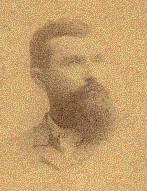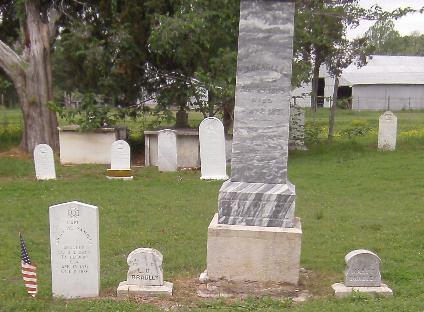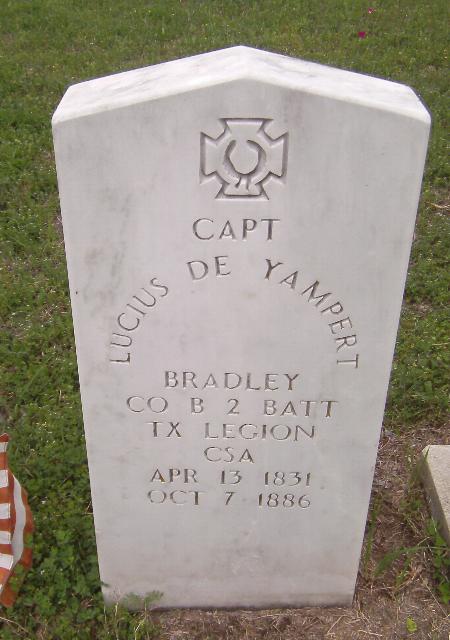The Pearce Civil War Collection
The son of Francis Meriwether Bradley and Zillah Pherabe Golsby Bradley, L.D. Bradley was born on April 13, 1831 in Dallas County, Alabama. In the winter of 1854 he moved to Fairfield, Freestone County, Texas after graduating from Transylvania University in Lexington, Kentucky. On September 22, 1859 he married Mary Grayson, also of Freestone County, Texas. They would eventually have nine children: Carolyn (known as Callie and Bobolinks in his letters), Annie, Mary (Minnie), L.D. Jr., James, George, Elizabeth, Alice, and Julia. From his letters, it is clear that L.D. Bradley loved his wife deeply and cared about his family a great deal.
Bradley practiced law in Freestone County and the surrounding area from 1855 to 1861. In 1861 he volunteered in a Texas regiment raised by Col. Young, but quickly moved to the new Legion formed by Col. T.N. Waul and raised a company of his own. Bradley's unit fought in Mississippi in defense of the city of Vicksburg in 1863 and during the siege Bradley led his company in a daring recapture of an important railroad redoubt. He was captured and paroled with the rest of the Confederate officers and returned to Texas with a remnant of Waul's Legion. The Legion was reorganized into Timmons's Regiment, although many men still considered themselves to be in Waul's Legion. Bradley spent the remainder of the war on the Texas Gulf Coast, guarding against Federal invasion and assisting blockade runners. During this time he was stationed at Velasco, Galveston, and Mud Island, among other places. Bradley did not see much action along the coast, and the majority of his tenure here was spent on Mud Island, a lonely, windswept island off of Galveston, from which he wrote many letters to his wife. At the close of the war, Bradley was stationed in Galveston, where he describes the deteriorating morale and discipline of the Confederate Army, despite their leaders' best efforts to keep spirits up. Bradley returned home after the war with depleted finances, but did not stay there for long. In 1866 Bradley's letters indicate that he was in the Texas State Legislature in the House of Representatives, and over the next two decades or so he would serve in the State Senate and as a District Judge.
L.D. Bradley died on October 6, 1886 while still serving as a District Judge. In the various memorials given after his death, he is remembered as being six feet tall, weighing 250 lbs. and having black eyes, curly black hair, and a swarthy complexion. According to his friends he supported the development of the railroad and was a member of the Knights Templar Palestine Commandery.
The Pearce Civil War Collection
The son of Francis Meriwether Bradley and Zillah Pherabe Golsby Bradley, L.D. Bradley was born on April 13, 1831 in Dallas County, Alabama. In the winter of 1854 he moved to Fairfield, Freestone County, Texas after graduating from Transylvania University in Lexington, Kentucky. On September 22, 1859 he married Mary Grayson, also of Freestone County, Texas. They would eventually have nine children: Carolyn (known as Callie and Bobolinks in his letters), Annie, Mary (Minnie), L.D. Jr., James, George, Elizabeth, Alice, and Julia. From his letters, it is clear that L.D. Bradley loved his wife deeply and cared about his family a great deal.
Bradley practiced law in Freestone County and the surrounding area from 1855 to 1861. In 1861 he volunteered in a Texas regiment raised by Col. Young, but quickly moved to the new Legion formed by Col. T.N. Waul and raised a company of his own. Bradley's unit fought in Mississippi in defense of the city of Vicksburg in 1863 and during the siege Bradley led his company in a daring recapture of an important railroad redoubt. He was captured and paroled with the rest of the Confederate officers and returned to Texas with a remnant of Waul's Legion. The Legion was reorganized into Timmons's Regiment, although many men still considered themselves to be in Waul's Legion. Bradley spent the remainder of the war on the Texas Gulf Coast, guarding against Federal invasion and assisting blockade runners. During this time he was stationed at Velasco, Galveston, and Mud Island, among other places. Bradley did not see much action along the coast, and the majority of his tenure here was spent on Mud Island, a lonely, windswept island off of Galveston, from which he wrote many letters to his wife. At the close of the war, Bradley was stationed in Galveston, where he describes the deteriorating morale and discipline of the Confederate Army, despite their leaders' best efforts to keep spirits up. Bradley returned home after the war with depleted finances, but did not stay there for long. In 1866 Bradley's letters indicate that he was in the Texas State Legislature in the House of Representatives, and over the next two decades or so he would serve in the State Senate and as a District Judge.
L.D. Bradley died on October 6, 1886 while still serving as a District Judge. In the various memorials given after his death, he is remembered as being six feet tall, weighing 250 lbs. and having black eyes, curly black hair, and a swarthy complexion. According to his friends he supported the development of the railroad and was a member of the Knights Templar Palestine Commandery.
Family Members
-
![]()
James Richard Bradley
1825–1846
-
Ann Eliza Bradley Heard
1828–1853
-
![]()
George T. Bradley
1833–1910
-
![]()
Thornton Boykin Bradley
1835–1861
-
Zillah Victoria Bradley Heard
1837–1861
-
![]()
Pherabe Elizabeth Bradley Moody
1839–1933
-
![]()
Martha Albina Bradley
1841–1849
-
![]()
Mary Frances Bradley
1845–1845
-
![]()
Francis Meriwether "Frank" Bradley Jr
1845–1905
Advertisement
Explore more
Sponsored by Ancestry
Advertisement



















